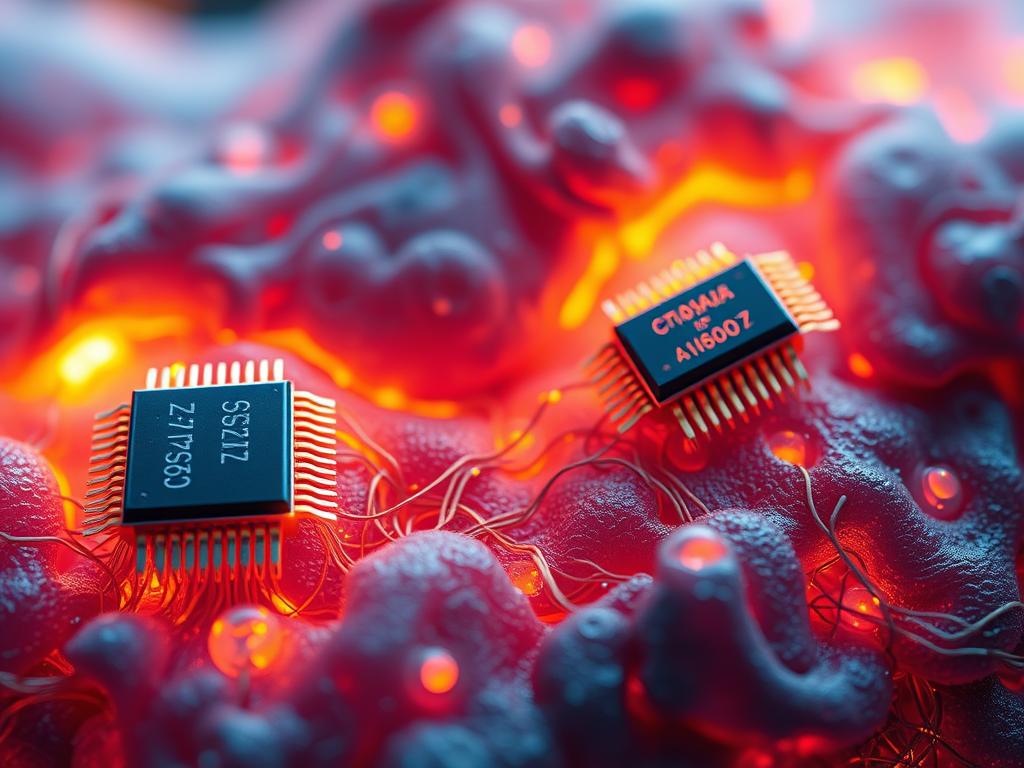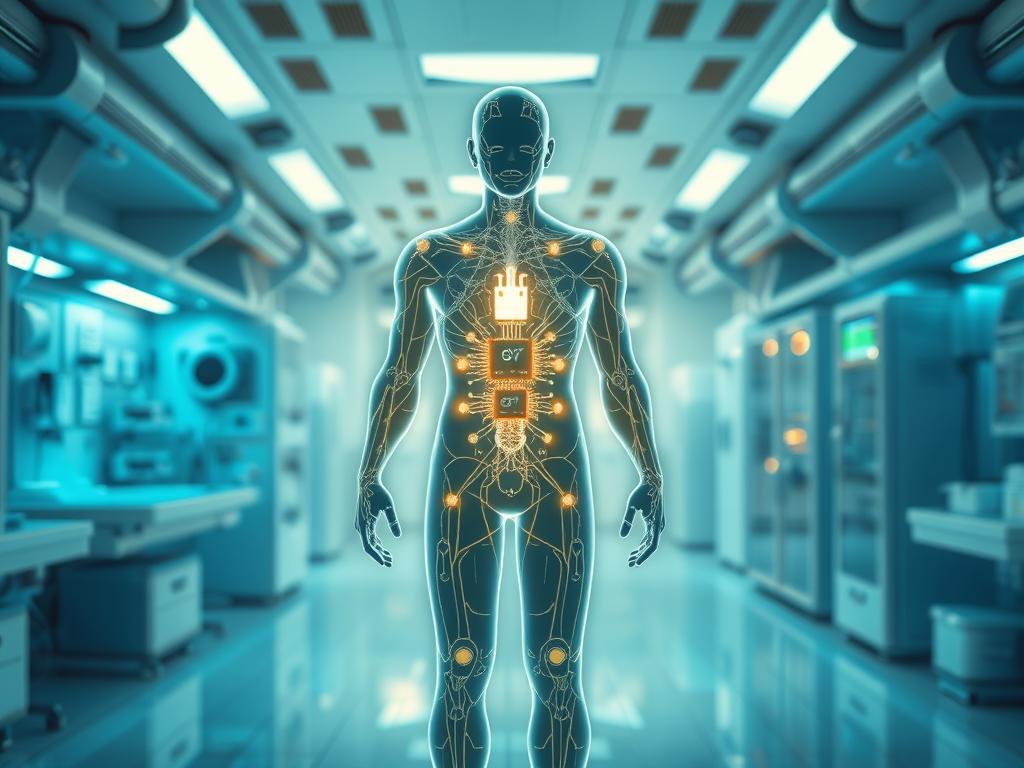Over 3 million people worldwide rely on implanted electronic devices for their health. This number will grow as biocompatible transistors revolutionize medical technology. These tiny marvels are creating a new era of implantable electronics that blend with our bodies.
Biocompatible transistors lead this medical breakthrough. They work in harmony with living tissue, enabling advanced health monitoring and treatment. These transistors safely interact with biological systems, opening new doors for personalized medicine.
Biosensors powered by biocompatible transistors are changing patient care. They enable continuous glucose monitoring for diabetes patients. They also create neural interfaces for controlling prosthetic limbs.
These devices improve our understanding of the human body. They enhance treatment outcomes for various medical conditions. The development of biology-friendly electronics faces challenges but offers exciting opportunities.
The path from idea to reality is filled with fascinating discoveries. Groundbreaking innovations are shaping the future of healthcare. Biocompatible transistors are at the heart of this medical revolution.
Biocompatibility Fundamentals
Biocompatible transistors merge electronics and biology. These devices function inside the body without harm. Let’s explore the key aspects that enable this technology.
Material Properties
Selecting the right materials is vital for biocompatible transistors. Biodegradable materials are crucial. They decompose over time, minimizing long-term risks.
Common materials include:
- Silk fibroin
- Poly(lactic-co-glycolic acid) (PLGA)
- Magnesium alloys
Body Response
A device entering the body triggers a reaction. Successful tissue integration is essential. The body should accept the transistor as part of its environment.
This process involves:
- Initial inflammation
- Cell attachment
- Tissue growth around the device
Safety Standards
Strict safety standards guide biocompatible transistor development. These rules ensure devices are safe for human use. Key focus areas include:
| Standard | Purpose |
|---|---|
| ISO 10993 | Biological evaluation of medical devices |
| ASTM F2129 | Corrosion testing of implants |
| IEC 60601 | Safety of medical electrical equipment |
These fundamentals shape safe, effective biocompatible transistors. By prioritizing materials, body response, and safety, researchers create devices that blend with human biology.
Device Design
Designing implantable electronics demands careful thought. The aim is to create devices that blend with the body smoothly. These devices must work reliably and integrate seamlessly.
Flexible Architecture
Implantable devices must be flexible. Designers use bendable materials and smart circuit layouts. These can withstand movement and pressure without losing function.

Size Optimization
Making devices smaller is a top priority. Tiny biosensors and neural interfaces are less invasive. They also cause less discomfort for patients.
Engineers use advanced techniques like nanotechnology. This helps them shrink parts while keeping them functional.
Power Management
Long-lasting implants need efficient power use. Designers use clever ways to extend battery life. This reduces the need for frequent replacements.
- Low-power circuit designs
- Energy harvesting from body heat or movement
- Wireless charging capabilities
| Design Aspect | Challenges | Solutions |
|---|---|---|
| Flexibility | Rigid materials, breakage | Stretchable substrates, serpentine circuits |
| Size | Reduced functionality | 3D stacking, nanoscale fabrication |
| Power | Limited battery life | Energy harvesting, wireless charging |
These design principles are vital for effective biosensors and neural interfaces. By tackling flexibility, size, and power issues, engineers create better implants. This leads to improved patient outcomes and new medical possibilities.
Manufacturing Process
Biocompatible transistors require careful manufacturing. These processes ensure the devices are safe for use in the human body. They must meet strict safety standards.
Clean Room Protocols
Fabrication takes place in spotless clean rooms. These spaces minimize contaminants that could harm device function. Workers wear special suits and follow strict rules to keep things clean.
Sterilization
After production, the transistors go through thorough sterilization. This step kills microorganisms without damaging delicate parts. Common methods include:
- Ethylene oxide gas treatment
- Gamma radiation exposure
- Low-temperature plasma sterilization
Quality Control
Strict testing ensures each transistor meets exact specs. Quality control measures include:
| Test | Purpose |
|---|---|
| Electrical performance | Verify signal processing capabilities |
| Mechanical stress | Assess durability under physical strain |
| Biocompatibility assays | Confirm safety for biological integration |
These thorough procedures ensure biocompatible transistors are reliable and safe. They are crucial for medical applications.
Integration with Biology
Biocompatible transistors are changing medical technology. They blend with living tissue, enabling new biosensors and neural interfaces. These devices can monitor and interact with the human body in amazing ways.

Tissue Interface
Successful tissue integration needs a smooth link between electronics and biology. Engineers create flexible, thin devices that match surrounding tissues. This reduces rejection and inflammation, allowing long-term use of biosensors in the body.
Signal Processing
Clear biological signals are vital for neural interfaces. Smart algorithms clean up noise and boost important data. This improves prosthetics and brain-computer interfaces, helping patients with neurological disorders.
Data Collection
Quick data collection from biosensors is key for health tracking. Wireless tech allows constant data flow without invasive procedures. This helps doctors monitor health trends and respond fast to changes.
- Miniaturized sensors for non-invasive monitoring
- Energy-efficient data transmission systems
- Secure encryption protocols for patient privacy
Tissue integration keeps improving, expanding the use of biocompatible transistors. These devices are changing patient care and pushing biomedical research forward. They offer new ways to detect diseases early and create personalized treatments.
Medical Applications
Biocompatible transistors are changing medical care. These tiny devices open new frontiers in biomedical applications. They enhance patient outcomes and treatment options.
Neural Interfaces
Neural interfaces use biocompatible transistors to connect brains and machines. They help treat neurological disorders by recording and stimulating neural activity.
Patients with paralysis can now control robotic limbs with their thoughts. This is possible thanks to advanced neural interfaces.
Diagnostic Tools
Biocompatible transistors are transforming healthcare diagnostics. Implantable biosensors can monitor vital signs and health markers continuously.
This real-time data allows for early detection of health issues. It also enables doctors to create personalized treatment plans.
Drug Delivery
Biocompatible transistors improve precision drug delivery systems. These devices can release medications at specific times or in response to body changes.
This targeted approach improves treatment effectiveness. It also reduces side effects, especially for chronic conditions like diabetes or cancer.
“Biocompatible transistors are not just improving existing treatments; they’re creating entirely new possibilities in medicine.”
Biocompatible transistors continue to expand in medical applications. They power advanced neural interfaces and sophisticated biosensors.
These devices are creating more effective, personalized healthcare solutions. They’re shaping the future of medicine.
Safety and Regulation
Biocompatible transistors for medical use must meet strict safety standards. These devices undergo thorough testing to ensure safety in biomedical applications. Rigorous approval processes are essential for their effectiveness.

Clinical Testing
Clinical trials are crucial for assessing biocompatible transistors’ safety. These tests evaluate device performance and potential side effects. Researchers conduct multiple trial phases, gradually expanding to larger groups.
FDA Approval
FDA approval is vital for implantable electronic devices. The process requires extensive documentation, including trial results and risk analyses. The FDA reviews this information to ensure devices meet all safety standards.
Risk Assessment
A thorough risk assessment helps identify potential hazards with biocompatible transistors. This process is essential for enhancing device safety and reliability.
- Analyzing potential failure modes
- Evaluating long-term biocompatibility
- Assessing electromagnetic interference risks
- Examining data security and privacy concerns
Addressing these aspects improves device safety and reliability. This paves the way for innovative biomedical applications. Ultimately, it enhances patient care and quality of life.
Long-term Performance
Implantable electronics’ longevity is vital for medical success. These devices must integrate with the body effectively. Understanding their performance over time is crucial for ongoing effectiveness.
Studying degradation, testing reliability, and developing maintenance strategies are key aspects. These factors ensure the devices remain functional and safe for patients.
Degradation Studies
Scientists study how biodegradable materials in implantable electronics break down. They track changes in device structure and function. This helps predict device lifespan and body interactions.
Reliability Testing
Implantable electronics undergo tough reliability tests. These simulate harsh body conditions like fluids, temperature changes, and stress. Engineers use results to improve designs and materials.
Maintenance Protocol
Maintaining implantable electronics is challenging because they’re inside the body. Engineers create innovative solutions to address this issue.
- Self-healing materials that repair minor damage
- Wireless charging systems to extend battery life
- Remote diagnostics to monitor device health
These advances reduce the need for invasive procedures. They also extend the useful life of implantable electronics. Technology improvements boost the long-term performance of these devices.
Patients benefit from more reliable and durable health solutions. This progress enhances the quality of life for those relying on implantable electronics.
Future Innovation
Biocompatible transistors are set to transform biomedical applications. These tiny marvels will reshape human-technology integration. We’re entering a new era in medical science and beyond.
New Materials
Scientists are developing materials for better functionality with living tissues. These innovations aim to improve biocompatible transistors for advanced biomedical uses. Self-healing polymers and nanoscale composites offer promising futures.
Advanced Integration
Researchers are creating natural interfaces between devices and living tissues. This could lead to implants that communicate better with the body. Such advancements may enhance neural prosthetics and smart drug delivery systems.
Novel Applications
Biocompatible transistors are expanding beyond traditional medical fields. They could monitor pollution levels in living organisms in real-time. Future developments might even bring us closer to direct brain-computer interfaces.
These advancements could open new paths for human augmentation and communication. The potential uses for biocompatible transistors are vast and exciting.


